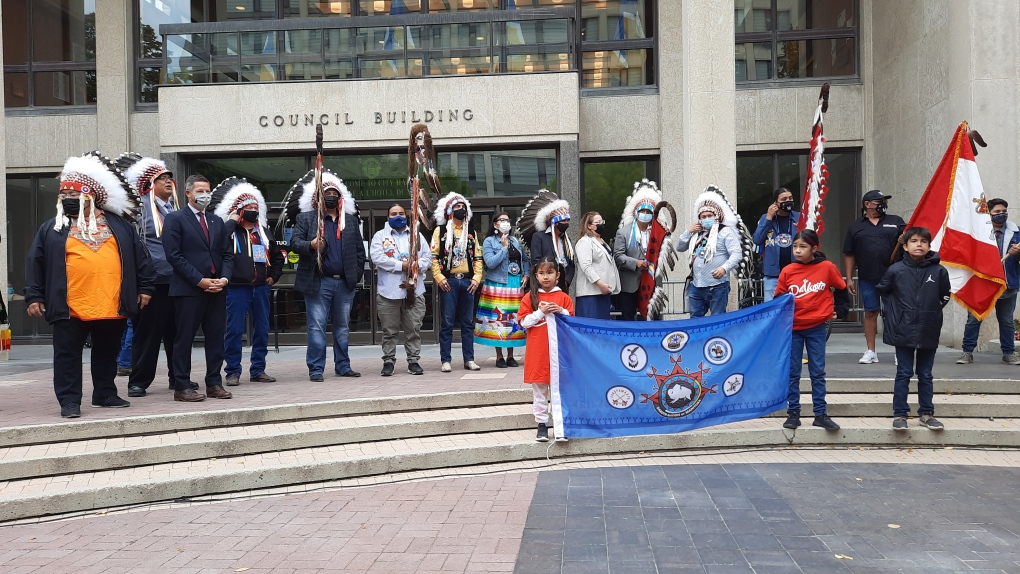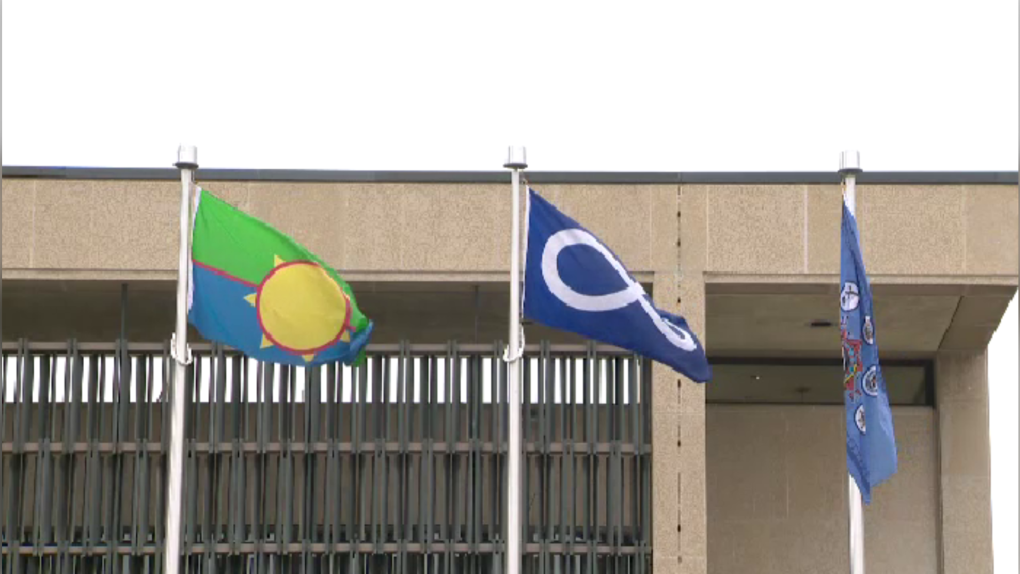'A truly significant moment': First Nations, Metis flags take permanent residency outside Winnipeg city hall
 Ceremonial flag raising at Winnipeg City Hall puts Dakota First Nations, Treaty One First Nations and Metis Nation flags on permanent display, Sept. 15 (Dan Timmerman, CTV News)
Ceremonial flag raising at Winnipeg City Hall puts Dakota First Nations, Treaty One First Nations and Metis Nation flags on permanent display, Sept. 15 (Dan Timmerman, CTV News)
Three flags have taken their permanent positions outside city hall as a symbol of Winnipeg’s ongoing commitment to Indigenous reconciliation.
A flag raising ceremony Wednesday morning sent three flags to the sky, representing Treaty One First Nations, Dakota Nations and the Metis Nation.
“We hope that the flags flying before city hall will be a visible statement of solidarity and respect,” said City of Winnipeg CAO Michael Jack.
In his opening remarks Mayor Brian described significance of the three flags. The white buffalo calf on the flag of the Dakota Nation of Manitoba symbolize sacred new beginnings.
Treaty One’s First Nation’s flag of a brilliant sun above a ground of blue and green reminds people the treaty will remain as long as the sun shines, the grass grows and the water flows.
The Metis Nation’s infinity flag signifies different cultures living in harmony forever.
 Indigenous flag raising at Winnipeg City Hall Sept. 15 (Dan Timmerman, CTV News)
Indigenous flag raising at Winnipeg City Hall Sept. 15 (Dan Timmerman, CTV News)
“They truly offer us images of beauty and images of power, images that can nourish resiliance of hope throughout our community,” said Mayor Brian Bowman. “Images that belong right here, in the seat of civic decision making because the people they represent belong right here.”
Metis, Treaty One and Dakota leaders were on-hand for the ceremonial flag raising, including Chief Dennis Meeches from Long Plain First Nation. He stressed the importance of everyone coming together, but said more work needs to be done.
“It’s been a long fight and a long journey for the treaty One Nations, Dakota Nations and Metis people but we celebrate the life our creator has given us, the blessings , even though we have struggled most of any people in this country,” said Meeches.
Grand Chief Arlen Dumas from the Assembly of Manitoba Chiefs reflected on his youth growing up in a remote and isolated community, and compared how far Indigenous reconciliation efforts have come.
“Here we are, light years ahead. I can tell you that I never would have imagined that we would be standing here together in solidarity, in light of the difficult history we’ve had,” said Dumas.
“It is a truly significant moment and to paraphrase our Dakota chiefs, this is what reconciliation really is, when we work together to bring forward in a meaningful way.”
Bowman said other reconciliation efforts are ongoing including the renaming of Bishop Grandin Boulevard. He also noted the economic reconciliation possibilities with the development of the property formally known as Kapyong and the city’s Indigenous Accord.
CTVNews.ca Top Stories

Why drivers in Ontario, Quebec and Atlantic Canada will see a gas price spike, and other Canadians won't
Drivers in Eastern Canada face a big increase in gas prices because of various factors, especially the higher cost of the summer blend, industry analysts say.
'A living nightmare': Winnipeg woman sentenced following campaign of harassment against man after online date
A Winnipeg woman was sentenced to house arrest after a single date with a man she met online culminated in her harassing him for years, and spurred false allegations which resulted in the innocent man being arrested three times.
How to avoid the trap of becoming 'house poor'
The journey to home ownership can be exciting, but personal finance columnist Christopher Liew warns about the trappings of becoming 'house poor' -- where an overwhelming portion of your income is devoured by housing costs. Liew offers some practical strategies to maintain better financial health while owning a home.
It's the biggest election in history. Here's why few Indians in Canada will take part
In the Indian general election that gets underway on Friday, almost a billion people are eligible to vote, but a vast majority of the overseas Indian community in Canada won't be casting a ballot.
McDonald's customers left with 'zero value' collection of free hot drink stickers after company ends program
It took years for Vinnie Deluca to collect more than 400 cards worth of free McDonald's McCafe coffee, a collection that now has "zero value" after the company discontinued the program.
Jury selection in Trump hush money trial faces pivotal stretch as former U.S. president returns to court
Jury selection in the hush money trial of Donald Trump enters a pivotal and potentially final stretch Thursday as lawyers look to round out the panel of New Yorkers that will decide the first-ever criminal case against a former president.
Toxic forever chemicals in drinking water: Is Canada doing enough?
As the United States sets its first national limits on toxic forever chemicals in drinking water, researchers say Canada is lagging when it comes to regulations.
Where did the gold go? Crime expert weighs in on unfolding Pearson airport heist investigation
Almost 7,000 bars of pure gold were stolen from Pearson International Airport exactly one year ago during an elaborate heist, but so far only a tiny fraction of that stolen loot has been found.
Biden scores endorsements from Kennedy family, looking to shore up support against Trump and RFK Jr.
U.S. President Joe Biden will accept endorsements from at least 15 members of the Kennedy political family during a campaign stop in Philadelphia on Thursday as he aims to undermine Donald Trump and marginalize the candidacy of Robert F. Kennedy Jr.































